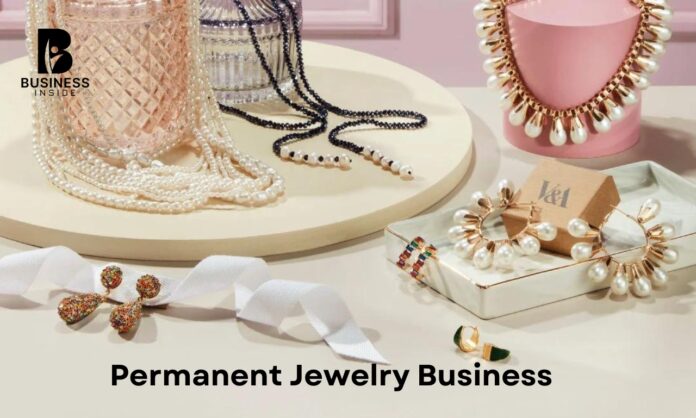Starting a permanent jewelry business can be an exciting and profitable venture if done correctly. Permanent jewelry, which typically includes items such as bracelets, necklaces, and anklets that are welded or soldered closed, is gaining popularity for its durability and the sentimental value it can hold. This article is a complete guide about the important steps to launch your permanent jewelry business successfully.
1.Market Research and Business Planning
Conduct Market Research:
Before diving into the business, it is crucial to conduct thorough market research. Understand the current trends in the jewelry industry and identify your target audience. Look at existing businesses to see what products are popular and what gaps might exist in the market.
Define Your Niche:
Long-lasting accessories appeal to different groups like trendy young people, upscal luxury buyers, or individuals looking for personalized, meaningful items. Identifying your specific target market will assist in customizing your promotional strategies and product creations.
2.Create a Business Plan
A complete business plan is the foundation of any successful business. Your business plan should include:
Executive Summary:
A solid highlight of your permanent jewelery business and its goals.
Market Analysis:
Insights from your market research.
Company Description:
Details about your business structure and the products you plan to offer.
Marketing Strategy:
Good strategies to attract potential customers.
Financial Plan:
Budget, pricing strategy, and projected income.
Operations Plan:
Daily operations, including supply chain management and staffing.
3.Legal and Financial Considerations
Register Your Business:
Select a unique business name and register it with the relevant authorities. Depending on
your location, you may need to register as a sole proprietor, partnership, LLC, or corporation.
Obtain Licenses and Permits:
Check local regulations to determine what licenses and permits you need to operate a jewelry business. This includes business license , sales tax permit, and potentially special licenses for handling precious metals and stones for your jewelry business.
Open a Business Bank Account:
Keep your personal and business finances distinct by setting up a specialized business bank account. This will help you manage your finances more effectively and maintain a professional image.
Insurance:
Invest in business insurance to protect against potential risks. This could involve having general liability coverage, property insurance, and product liability protection.
4:Setting Up Your Workshop
Secure a Workspace:
You will need a workshop equipped with the necessary tools and materials. This could be a dedicated space in your home or a rented studio. Ensure that your workspace meets all safety regulations.
Invest in Equipment:
Key equipment for a permanent jewelry business includes:
Welding/Soldering Equipment:
Essential for creating permanent pieces.
Jewelry Tools:
Pliers, cutters, hammers, and other hand tools.
Safety Gear:
Goggles, gloves, and ventilation systems.
Storage Solutions:
Organizers for materials and finished pieces.
Source Materials:
Find reliable suppliers for your materials, such as metals (gold, silver, platinum), gemstones, and other components. Quality is crucial, so ensure your suppliers are reputable.
5.Designing and Creating Jewelry
Develop Unique Designs:
Your designs will set you apart from competitors. Consider hiring a professional jewelry designer if needed or take courses to hone your skills.
Prototype and Test:
Create prototypes of your designs and test them for durability and wear ability. This stage is critical to ensuring the quality and longevity of your products.
6.Building Your Brand
Create a Brand Identity:
Establish a solid brand image that mirrors your business principles and attracts your desired customer base. This encompasses your business title, emblem, color palette, and overall visual style.
Build a Website:
A professional website is necessary for advertising your products and reaching a broader audience. Include high-quality photos of your jewelry, detailed product descriptions, and an easy-to-use shopping cart. Consider adding a blog to share stories, tips, and news related to your jewelry and the industry.
Social Media Presence:
Use social media platforms to promote your jewelry and engage with potential customers. Social media platforms like Instagram, Pintrest, and Facebook are particularly effective for visual products like jewelry. Regularly post updates, the process of manufacturing of products content, question answer sessions and engage with your followers.
7.Marketing and Sales
Develop a Marketing Strategy:
Incorporate a mix of digital and traditional methods in your marketing plan. Digital tactics could involve social media promotions, email campaigns, search engine optimization (SEO), and internet advertisements. Other strategies could be participating in local craft fairs, hosting pop-up shops, and networking within your community.
Pricing Your Products:
Setting the right prices for your jewelry is key. Factor in material costs, labor, business expenses, and the profit you aim for. Check out competitors’ prices to make sure your products are priced competitively.
Sales Channels:
Decide where you will sell your jewelry. Options include your website, online marketplaces (such as Etsy), physical retail locations, and craft fairs. Each channel has its own advantages and challenges, so choose the ones that best fit your business model.
8.Customer Service and Retention
Delivering top-notch customer service is essential. Ensuring customer satisfaction is crucial for nurturing a loyal clientele. Offer exceptional service throughout the shopping journey and provide prompt responses to inquiries, handling any concerns with professionalism.
Offer Customization:
Offering customization options can set your business apart. Allow customers to choose materials, stones, and designs to create personalized pieces. This adds value and can increase customer loyalty.
Implement a Loyalty Program:
A loyalty program can encourage repeat business. Offer discounts, exclusive deals, or early access to new collections for returning customers.
9.Keep Accurate Records
Keeping records will help you make informed business decisions and simplify tax filing.
Monitor Inventory:
Monitor your stock carefully to have the necessary materials without excess. Utilize inventory management software to simplify this task.
Stay Updated on Trends:
The jewelry industry is constantly evolving, so stay updated on the latest trends and innovations. Attend industry events, follow fashion influencers, and continuously seek inspiration to keep your designs fresh and relevant.
Conclusion
Starting a permanent jewelry business involves careful planning, creativity, and a commitment to quality. With consistency and hard work, your permanent jewelry business can become a cherished brand for customers seeking unique, long-lasting pieces.
`

